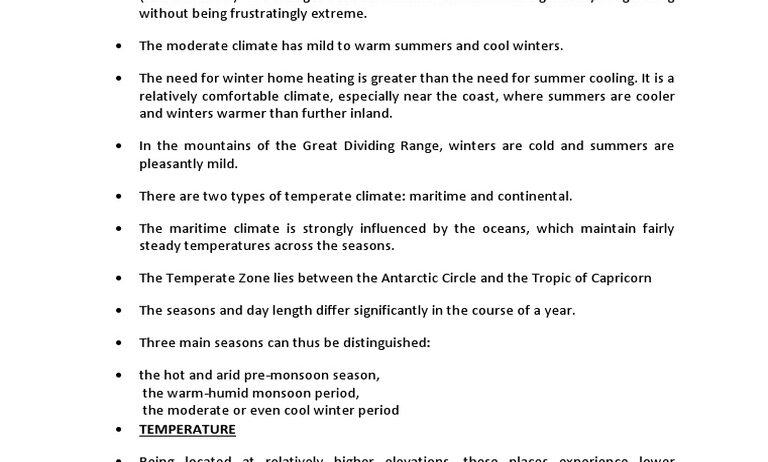Temperate climate is an intricate mosaic of weather patterns, characterized by its mild temperatures and distinct seasonal changes. This climate zone exists between the polar and tropical regions, granting it unique attributes that appeal to both environmentalists and everyday inhabitants alike. With its captivating amalgamation of flora, fauna, and environmental dynamics, the temperate climate conjures a realm that presents both comfort and variety.
Understanding the temperate climate requires a nuanced examination of its fundamental features. This includes not only the average temperature but also precipitation patterns, seasonal shifts, and the resulting ecological consequences. A dive into the layers of this climate zone beckons exploration of its diverse landscapes, intricate ecosystems, and the human experiences intertwined with them.
Climate Zones: A Spectrum of Diversity
The temperate climate is broadly divided into two primary subcategories: the humid subtropical and the oceanic climate. Each of these zones possesses its own idiosyncratic characteristics.
In the humid subtropical region, the presence of warm summers and mild winters defines the weather patterns. Rainfall is substantial and distributed throughout the year, which results in the flourishing vegetation that typifies this climate. Think of lush green forests, expansive agricultural fields, and the vibrant beauty of blossoming flowers. These areas often showcase a remarkable biodiversity, supporting a plethora of animal species that thrive peacefully within this environment.
Contrasting this, the oceanic climate boasts cooler temperatures year-round, with a strong maritime influence. Regions subjected to this climatic designation experience level temperatures, with neither extreme heat nor cold prevailing. The winters are typically damp and cool, while summers are pleasantly warm, accompanied often by frequent rain showers. This steady precipitation creates an environment that nurtures thick woodlands and nourishes a myriad of aquatic life in nearby rivers and oceans.
Seasonal Transformations: The Beauty of Change
One of the most captivating aspects of temperate climates is their pronounced seasonal variability. The dramatic changes from one season to the next offer both visual splendor and functional benefits for ecosystems. Spring bursts forth with vitality; plants awaken from winter dormancy, and animals emerge from hibernation. This revitalization brings flowers into bloom and heralds a time of abundance, as wildlife and people alike engage in the vibrant tapestry of life.
Summer arrives with warmth and longer days, promoting outdoor activities and agricultural pursuits. The temperate climate often supports an array of crops that thrive during this time. Subtropical regions might yield citrus, while oceanic areas may flourish in grains and legumes. Summer can, however, bring bouts of intense rainfall or storms, which, while potentially destructive, act as a vital component of the local hydrological cycle.
Autumn paints the landscapes with warm hues—gold, crimson, and amber cloak forests and gardens. This transitional period is essential for many species as they prepare for the dormant months ahead. Trees shed their leaves, and animals engage in behaviors such as caching food or migrating to warmer locales. The spectacle of autumn foliage not only captivates the senses but also highlights the cyclical nature of life that the temperate climate so eloquently embodies.
Winter arrives, cloaking the land in a serene stillness. While snow might blanket some areas, other regions maintain a more temperate approach with mild winters. This season provides a restful respite for ecosystems, allowing nutrients to cycle through the soil without the distraction of rampant growth. Winter can be viewed not merely as a period of dormancy, but as a preparatory phase for the vitality that spring promises.
Impact on Biodiversity: Thriving Amidst Diversity
Life in the temperate climate thrives on adaptation. Each season brings unique challenges and opportunities that flora and fauna meet with resilience. The diversity of plant life ranges from hardy pines to delicate deciduous trees, showcasing an impressive spectrum that fosters a variety of animal species. Birds, mammals, insects, and aquatic life find their niches here, creating complex interdependent systems.
This richness is not confined to land. Rivers, lakes, and coastal areas within temperate climates serve as habitats for countless aquatic organisms, ensuring that biodiversity has multiple avenues through which to unravel. However, it is essential to recognize that this vibrancy can be at risk due to climate change and human encroachment. As these threats loom, the temperate climate stands at a precipice, begging for our awareness and action.
Human Connection: Cultivating a Sustainable Future
The temperate climate has long served as a fertile ground for human habitation, agriculture, and innovation. Its seasons dictate how societies engage with their environment, influencing everything from clothing to food production. Human activity too often leads to disruption, resulting in adverse impacts on ecosystems and local climates.
Nevertheless, there exists an opportunity for harmonious coexistence. Sustainable farming practices, conservation efforts, and a collective way of living can foster a balance that is beneficial for both humanity and the environment. By harnessing the natural gifts of the temperate climate while mindful of its limits, we can establish a legacy of respect and stewardship.
In conclusion, the temperate climate offers more than just mild temperatures; it embodies a story of diversity, transformation, and possibility. By exploring its nuances, understanding its intricacies, and committing to its preservation, we can embrace a future filled with knowledge, connection, and appreciation for this captivating climate zone.






